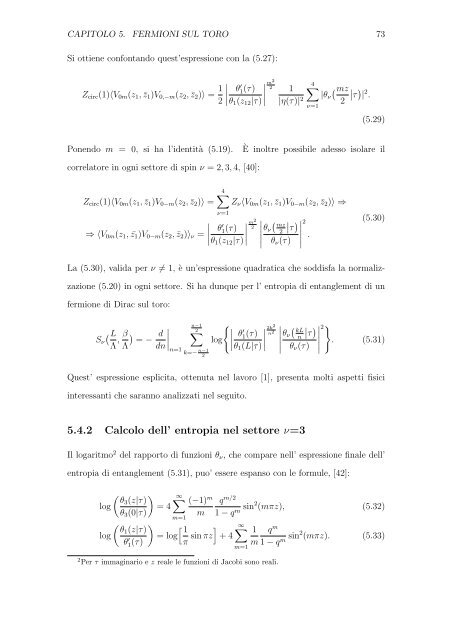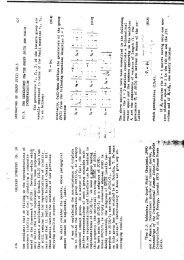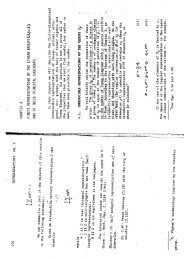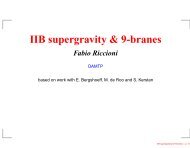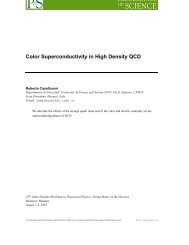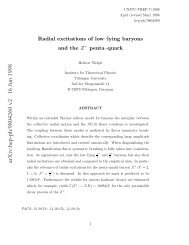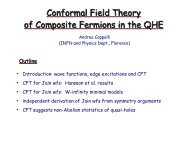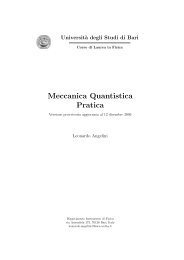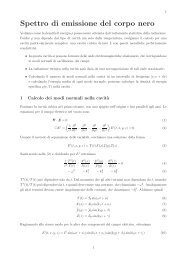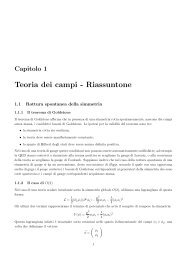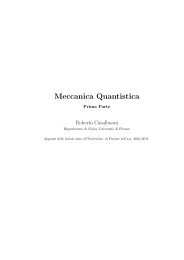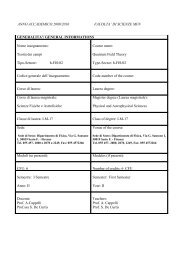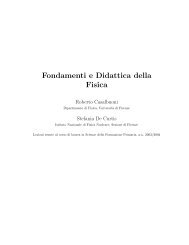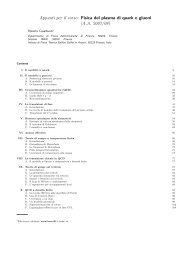entropia di entanglement in teorie invarianti conformi bidimensionali
entropia di entanglement in teorie invarianti conformi bidimensionali
entropia di entanglement in teorie invarianti conformi bidimensionali
You also want an ePaper? Increase the reach of your titles
YUMPU automatically turns print PDFs into web optimized ePapers that Google loves.
CAPITOLO 5. FERMIONI SUL TORO 73<br />
Si ottiene confontando quest’espressione con la (5.27):<br />
Zcirc(1)〈V0m(z1, ¯z1)V0,−m(z2, ¯z2)〉 = 1<br />
2<br />
<br />
<br />
<br />
θ<br />
<br />
′ <br />
1(τ) <br />
<br />
θ1(z12|τ) <br />
m 2<br />
2 1<br />
|η(τ)| 2<br />
4 mz <br />
|θν 2<br />
τ | .<br />
2<br />
ν=1<br />
(5.29)<br />
Ponendo m = 0, si ha l’identità (5.19). È <strong>in</strong>oltre possibile adesso isolare il<br />
correlatore <strong>in</strong> ogni settore <strong>di</strong> sp<strong>in</strong> ν = 2, 3, 4, [40]:<br />
Zcirc(1)〈V0m(z1, ¯z1)V0−m(z2, ¯z2)〉 =<br />
4<br />
Zν〈V0m(z1, ¯z1)V0−m(z2, ¯z2)〉 ⇒<br />
ν=1<br />
<br />
<br />
⇒ 〈V0m(z1, ¯z1)V0−m(z2, ¯z2)〉ν = <br />
θ<br />
<br />
′ <br />
1(τ) <br />
<br />
θ1(z12|τ) <br />
m 2<br />
2<br />
<br />
<br />
<br />
<br />
<br />
θν<br />
<br />
mz τ <br />
2 <br />
<br />
θν(τ) <br />
2<br />
.<br />
(5.30)<br />
La (5.30), valida per ν = 1, è un’espressione quadratica che sod<strong>di</strong>sfa la normaliz-<br />
zazione (5.20) <strong>in</strong> ogni settore. Si ha dunque per l’ <strong>entropia</strong> <strong>di</strong> <strong>entanglement</strong> <strong>di</strong> un<br />
fermione <strong>di</strong> Dirac sul toro:<br />
Sν<br />
<br />
L β d <br />
, = − <br />
Λ Λ dn<br />
n=1<br />
n−1<br />
2<br />
k=− n−1<br />
2<br />
θ<br />
log<br />
′ <br />
1(τ) <br />
<br />
θ1(L|τ) <br />
2k 2<br />
n 2<br />
<br />
<br />
<br />
<br />
<br />
θν<br />
<br />
kLτ<br />
2<br />
n <br />
. (5.31)<br />
θν(τ) <br />
Quest’ espressione esplicita, ottenuta nel lavoro [1], presenta molti aspetti fisici<br />
<strong>in</strong>teressanti che saranno analizzati nel seguito.<br />
5.4.2 Calcolo dell’ <strong>entropia</strong> nel settore ν=3<br />
Il logaritmo 2 del rapporto <strong>di</strong> funzioni θν, che compare nell’ espressione f<strong>in</strong>ale dell’<br />
<strong>entropia</strong> <strong>di</strong> <strong>entanglement</strong> (5.31), puo’ essere espanso con le formule, [42]:<br />
∞<br />
θ3(z|τ) (−1)<br />
log<br />
= 4<br />
θ3(0|τ)<br />
m=1<br />
m q<br />
m<br />
m/2<br />
1 − qm s<strong>in</strong>2 (mπz), (5.32)<br />
<br />
θ1(z|τ)<br />
log<br />
θ ′ <br />
1<br />
∞ 1 q<br />
= log s<strong>in</strong> πz + 4<br />
1(τ) π m<br />
m<br />
1 − qm s<strong>in</strong>2 (mπz). (5.33)<br />
m=1<br />
2 Per τ immag<strong>in</strong>ario e z reale le funzioni <strong>di</strong> Jacobi sono reali.


